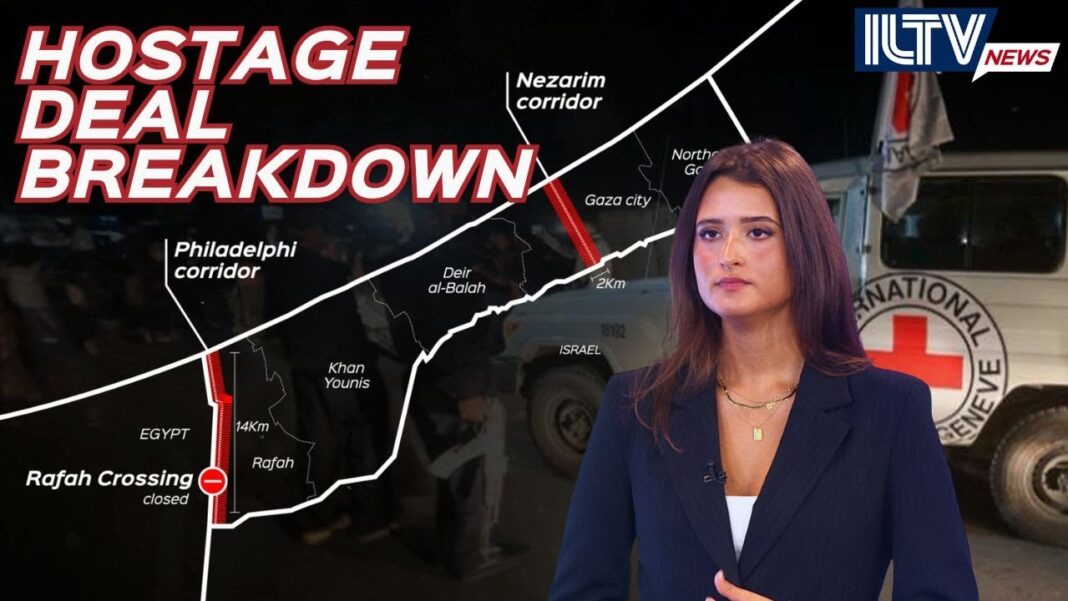|
Getting your Trinity Audio player ready...
|
Hostage Deal Highlights: Thousands of Palestinian Terrorists to Be Released from Israeli Prisons
By: Fern Sidman
The international community has successfully brokered a controversial and high-stakes hostage deal between Israel and Hamas, bringing hope for families torn apart by the conflict that began on October 7, 2023. This agreement, mediated by the United States, Egypt, and Qatar calls attention to the ongoing efforts to navigate humanitarian concerns amidst one of the region’s most prolonged and intense crises. The deal is set to take effect on Monday, January 20, 2025.
The conflict erupted on October 7, 2023, when Hamas launched a devastating attack on southern Israel, brutally massacring over 1,200 Israelis and taking 251 hostages. Over 15 months of war have left a heavy toll, and as such, global leaders have called for a de-escalation of hostilities that ultimately culminated in this multi-phased agreement. The deal promises the release of hostages, including Israeli and American citizens, in exchange for Palestinian security prisoners, many of whom are convicted terrorists serving life sentences.
The agreement unfolds over three distinct phases spanning six weeks. During this time, Hamas is expected to release 33 hostages, including women, children, elderly individuals, and injured civilians. Concurrently, Israel will release 50 Palestinian terrorist prisoners for every group of five female hostages freed. Among the prisoners to be released are individuals serving sentences for terrorism-related activities, marking a controversial element of the agreement.
Phase One: Immediate Releases and Provisions
Phase One of the deal initiates with the release of three hostages on the first day, followed by incremental releases over the subsequent weeks. By the conclusion of this phase, 33 hostages, including dual Israeli-American citizens and children as young as 2 years old, will be reunited with their families. Among the key figures in this phase are:
Kfir Bibas, 2, and Ariel Bibas, 5: The youngest hostages, held alongside their parents, Yarden and Shiri.
Keith Siegel, 65, and Sagui Dekel-Chen, 36: Dual Israeli-American citizens.
Shlomo Mantzur, 86: The oldest individual in captivity.
Here is the full list:
Romi Gonen, 23
Emily Damari, 27
Arbel Yehud, 29
Doron Steinbrecher, 31
Ariel Bibas, 5
Kfir Bibas, 2
Shiri Silberman Bibas, 33
Liri Albag, 19
Karina Ariev, 20
Agam Berger, 21
Danielle Gilboa, 20
Naama Levy, 20
Ohad Ben-Ami, 58
Gadi Moshe Moses, 80
Keith Siegel, 65
Ofer Calderon, 54
Eli Sharabi, 52
Itzik Elgarat, 70
Shlomo Mansour, 86
Ohad Yahalomi, 50
Oded Lifshitz, 84
Tsahi Idan, 50
Hisham al-Sayed, 36
Yarden Bibas, 35
Sagui Dekel-Chen, 36
Yair Horn, 46
Omer Wenkert, 23
Sasha Trufanov, 28
Eliya Cohen, 27
Or Levy, 34
Avera Mengistu, 38
Tal Shoham, 39
Omer Shem-Tov, 22
Humanitarian and Strategic Provisions
To facilitate the deal, Israel has agreed to several measures, including partial withdrawal of troops from specific areas in Gaza, while retaining control of strategic points such as the Gaza-Egypt border, known as the Philadelphi Corridor, to prevent further smuggling of weapons by Hamas. It also includes increasing the daily entry of humanitarian aid trucks into Gaza from 250 to 600, aimed at alleviating the suffering of displaced Palestinians.
Despite these concessions, Israeli forces will maintain the right to respond to threats emanating from Gaza.
The deal has sparked both hope and controversy. Critics question the wisdom of releasing convicted terrorists, fearing it may incentivize future kidnappings. Meanwhile, proponents highlight the urgency of rescuing hostages and addressing humanitarian needs. With Hamas still holding 94 hostages, including the remains of soldiers killed in past conflicts, concerns linger over the group’s long-term strategy and the precedent set by the exchange.
The deal has drawn a mixed response on the global stage. Humanitarian organizations have welcomed the agreement as a critical step toward alleviating suffering, while skeptics, including members of Israel’s government, caution against the risks of emboldening terrorist groups. Domestically, the agreement has rekindled debates about the balance between security and humanitarian responsibility.
Phase Two: Negotiating the Release of Remaining Hostages
Phase Two of the deal hinges on successful negotiations between Israel and Hamas, set to begin 16 days after the implementation of Phase One. This phase will focus on the release of 65 remaining hostages, most of whom are male Israeli soldiers. It also introduces broader ambitions, including a permanent ceasefire and the complete withdrawal of Israeli troops from Gaza.
Among those whose release is anticipated in this phase is Edan Alexander, a 21-year-old dual American-Israeli citizen who joined the Israel Defense Forces (IDF) after high school in New Jersey. His family last saw him in a propaganda video released by Hamas following Thanksgiving. The uncertainty surrounding the condition and whereabouts of these hostages adds a layer of urgency to the negotiations.
Phase Two stipulates the full withdrawal of Israeli troops from Gaza, a move likely to alter the operational landscape in the territory. Israel has voiced concerns over Hamas’s potential resurgence and remains firm on excluding both Hamas and the Palestinian Authority (PA) from post-war governance.
Phase Three: Recovery of Hostages’ Remains and Gaza Reconstruction
The final phase of the agreement shifts focus to the humanitarian and infrastructural rebuilding of Gaza. This stage includes the return of the bodies of remaining hostages in exchange for a multi-year Gaza reconstruction plan, overseen by international organizations.
Four Americans—Itay Chen (19), Omer Neutra (23), Gadi Haggai (73), and Judi Weinstein Haggai (70)—are among those believed to have been killed. Their remains, alongside those of 37 hostages already recovered by Israeli troops, are expected to be returned during this phase.
Spanning three to five years, this plan aims to restore essential infrastructure in Gaza, ensuring access to basic services for its population. However, the question of governance remains unresolved. Israel has made clear that neither Hamas, which has controlled Gaza since 2007, nor the Palestinian Authority, ousted from Gaza by Hamas, will be acceptable overseers.
Controversy Surrounding Palestinian Prisoner Releases
The release of Palestinian prisoners has sparked widespread debate, with some individuals and groups adamantly opposed to the potential inclusion of individuals convicted of heinous acts of terrorism. Among those excluded from release are Marwan Barghouti, a prominent figure in Palestinian politics and a leader of the al-Aqsa Martyrs’ Brigades. Barghouti is currently serving multiple life sentences for orchestrating deadly attacks during the First and Second Intifadas. Also excluded from possible release is Ahmad Sa’adat, a leader of the PFLP, an internationally designated terrorist organization responsible for several high-profile attacks, including the assassination of Israeli Tourism Minister Rehavam Ze’evi in 2001..
Future Implications
The success of these phases will have far-reaching consequences for the region. While the return of hostages is a humanitarian necessity, the broader terms of the agreement—particularly the release of convicted terrorists and the potential for Hamas to regain strength—pose significant risks. Israel’s insistence on maintaining sovereignty and preventing a return to pre-October 7 vulnerabilities will remain central to its strategy.
Meanwhile, the question of who will govern Gaza in the aftermath looms large. With Hamas and the Palestinian Authority both sidelined, international stakeholders may need to spearhead an entirely new framework for the region’s administration.






It’s just so tragic. By withdrawing from the Philadelphi Corridor (which Netanyahu’s government is publicly denying, but will do) they are just laying the groundwork for future October 7th’s.